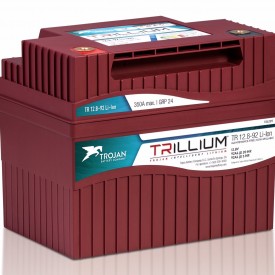Trojan Battery recently announced the Trillium line of Trojan Intelligent Lithium batteries, which has a life expectancy of more than 5,000 cycles.
“This is another significant milestone towards our strategic mission of offering a complete range of deep-cycle energy storage technologies and solutions for our customers,” said Neil Thomas president and CEO of Trojan Battery. “The addition of a highly competitive Lithium product line further strengthens our best-in-class technology portfolio.”
Trillium is designed and engineered in the U.S. and is initially available in three sizes intended for a variety of applications.
“It was important for us to incorporate intelligent solutions including advanced cell technology, sophisticated electronics and easy integration for our customers,” said Ivan Menjak, Trojan’s director of global product solutions. “We have incorporated industry-standard 26650-size lithium-iron phosphate cells and the highest capacity cell configuration to provide market-leading cycle life and energy density. This allows for lower initial cost of energy as well as decreased total cost of ownership over the life of the battery.”
Trillium is designed to be a replacement for existing lead acid batteries, the company stated. The built-in battery protection system guards the battery from the extreme demands of various motive and stationary applications. Additionally, OEM customers can add the Trillium range of products into equipment without significant investments in custom pack design and development.
“Trojan’s entry into the lithium-ion space demonstrates our commitment to offering energy storage solutions for our customers in deep-cycle industrial segments and allows for expansion into exciting new markets,” said Bryan Godber, Trojan Battery’s executive VP of marketing and product management. “With over 90 years of battery technology expertise and application knowledge, we can provide premium solutions optimized for our target applications.”
Trillium features automotive-grade safety components, CAN-bus communication and an integrated state-of-charge indicator. The electronic controls allow for voltage compatibility for all 12-, 24-, 36- and 48-volt applications including the ability to use most existing lead-acid chargers.
